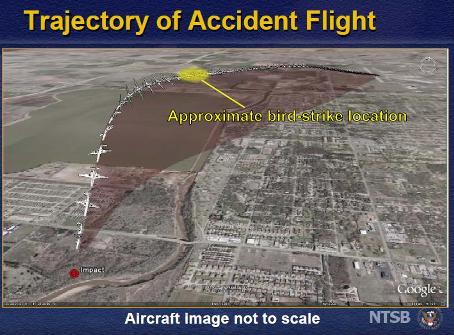The US National Transportation Safety Board (NTSB) has concluded that a collision with a flock of American white pelicans at 945m (3,100ft) most likely damaged the wing of a Cessna Citation 500 jet that had just departed the Wiley Post Airport in Oklahoma City on 4 March 2008, causing it to roll inverted and plunge to the ground in a near-vertical attitude roughly four miles south of the airport.
Investigators determined that the aircraft’s right engine had ingested one of the pelicans, which weigh between 4.5kg (10lb) to 13.5kg, and was not operating at impact, though the failure was determined not to be causal to the loss-of-control (LOC).
 |
|---|
©NTSB |
The two pilots and three passengers onboard the twin-jet, which had been operating officially as a Part 91 general aviation flight but unofficially as a Part 135 charter, were killed in the crash.
At the time of the crash, air traffic control radar data revealed a “trail of primary targets” consistent with birds that “moved westward from the collision point and then reversed direction and headed in a north easterly direction.”

Though it is located adjacent to a wildlife refuge, the NTSB notes that Wiley Post Airport had not performed a wildlife assessment, as called out in FAA advisory circulars, which may have revealed mitigation measures “that could have been implemented to reduce the risk of an in-flight collision with American white pelicans”. The airport does however use preventative measures within its boundaries.
Ten new safety recommendations forwarded to the FAA focus not only on wildlife hazards, but also on boosting public protection when booking charter flights.
“It reminds me of a Three Stooges set up of ‘Who’s on First’,” said NTSB board member Debbie Hersman, describing the fact that no one interviewed after the accident -- the company that thought it was booking a Part 135 flight for its employees; Interstate Helicopters, the charter company they called, but whose Part 135 certificate covered helicopters only; the Citation owner's pilot with whom Interstate contacted to gain access to the jet; or the Citation owner himself -- claimed to be the operator of the flight.
A series of earlier complaints brought to the FAA about Interstate operating fixed wing aircraft had been investigated but the agency was not able to secure records that NTSB later found showing the improper operations. The NTSB is asking that the FAA’s truth-in-leasing regulations be modified to include all turbine-powered airplanes and that the agency figure out why it failed to detect the "non-compliant practices" at Interstate, among other actions.
Regarding bird strikes, NTSB recommendations include asking the FAA to require aircraft manufacturers to provide quantitative data, potentially in the form of charts, which include maximum airspeeds in which a collision with a bird of a certain weight will not exceed the airframe certification requirements of the aircraft.
Source: FlightGlobal.com



















